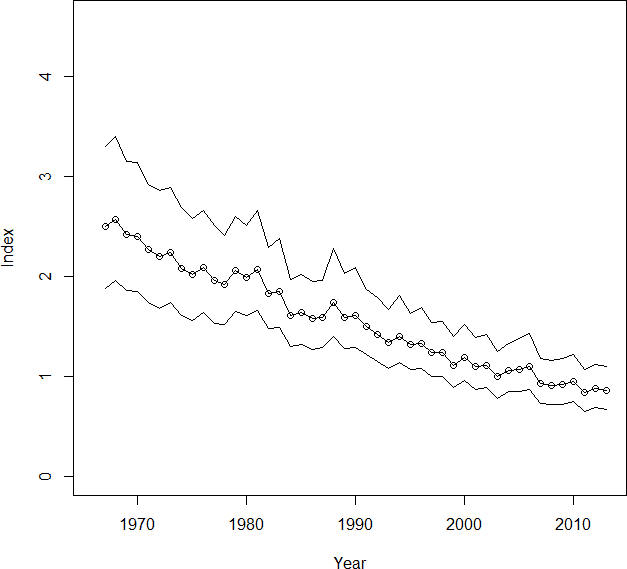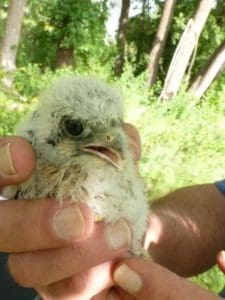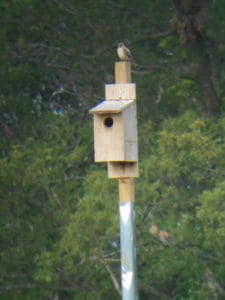American Kestrel Nest Box Monitoring
The Kestrel Nest Box Project of the Saint Paul Audubon Society Conservation Committee
Members of the SPAS Conservation Committee began placing nest boxes for American Kestrels in the east metro area in 2012. American Kestrels have declined steadily in Minnesota, as shown by the following chart of occurrences per Breeding Bird Survey route of the U. S. Fish and Wildlife Service in Minnesota from 1966 to 2013.
The Conservation Committee saw a nest box project as a way to help kestrels since they typically nest in tree cavities, which are in short supply. The species account of American Kestrels in Birds of North America Online states: “Nest boxes, commonly employed for studies of wild kestrels, shown to be beneficial to those populations ….”
Obtaining and installing nest boxes and poles
We have placed six kestrel nest boxes thus far, at the locations shown in this Google map. The boxes are made of cedar, which lasts longer than pine, and we add a bed of aspen chips. Without the chips, the female kestrel will lay eggs on the bare wood floor, and they will probably not hatch because the kestrels cannot keep the eggs warm and together.
American Kestrels prefer a nesting territory of at least 50 acres of short vegetation with some trees, utility poles, wires, or other places to perch. Their main food during the nesting season is small mammals (voles, mice) and large insects.
To mount the boxes, we ask the host site to provide poles that extend about 15 feet above ground. We attach the box with its entrance 12-14 feet high, facing southeast. To deter predators from climbing the pole, we wrap one or two pieces of 30” x 40” aluminum around the pole. These are used photographic plates, donated by GLS Companies, Bandana Square, St. Paul. Much of our knowledge of kestrels’ preferences comes from the kestrel nest box program at the National Guard’s Arden Hills Army Training Site.
Monitoring
We recruit a volunteer to monitor each nest box. Monitors observe boxes at least once a week during the nesting season to determine whether kestrels, or other species, appear to be nesting.
European Starlings sometimes nest in kestrel boxes. If we see starlings using a box, we will remove the starling nest and eggs. (An alien species, European Starlings are not protected.) If a native species uses a box, we will not interfere. Starlings have the nasty habit of removing the aspen chips. That happened without our detection at one of our Lake Elmo boxes in 2014. Kestrels came along and laid four eggs, which did not hatch.
Kestrel eggs hatch after about four weeks of incubation, and the young fledge about a month later. If it appears that kestrels are incubating eggs, we inspect the contents of the box with a pole-mounted camera connected to a laptop computer. This does not require a ladder, and it causes minimal disturbance to the birds. If a full clutch of four or five eggs is present, we return about a month later to check for kestrel chicks. We estimate the age of the chicks, and try to have the monitor observe the box (from a distance) at about the expected time of fledging. We may also arrange for the chicks to be banded at the age of about 20 days.
In the days leading up to fledging, the young kestrels can often be seen looking out of the box. After fledging, the young remain in the area for about two weeks, sometimes perching on the box, while the parents continue to capture food for them.
In the fall, we check each box and, if necessary, clean it out and replace the aspen chips.
A kestrel chick waits patiently for its band.
A recently fledged mail atop nest box LEPR02.
Reporting to the American Kestrel Partnership
Our nest box project contributes data to a continent-wide research program conducted by the American Kestrel Partnership, which is a creation of The Peregrine Fund. We enter our nesting data on American Kestrel Partnership’s website.
Results thus far
This table shows the nesting results for each of our nest boxes.
The future
We hope to add more nest boxes if we can enlist monitors and gain cooperation from organizations or persons with potential nest sites. If your organization or business has suitable kestrel habitat nearby and you would like to host these beautiful little falcons, please contact us at Contact
And let us know if you would like to join in the installation, maintenance, and/or monitoring of nest boxes.
Julian Sellers




